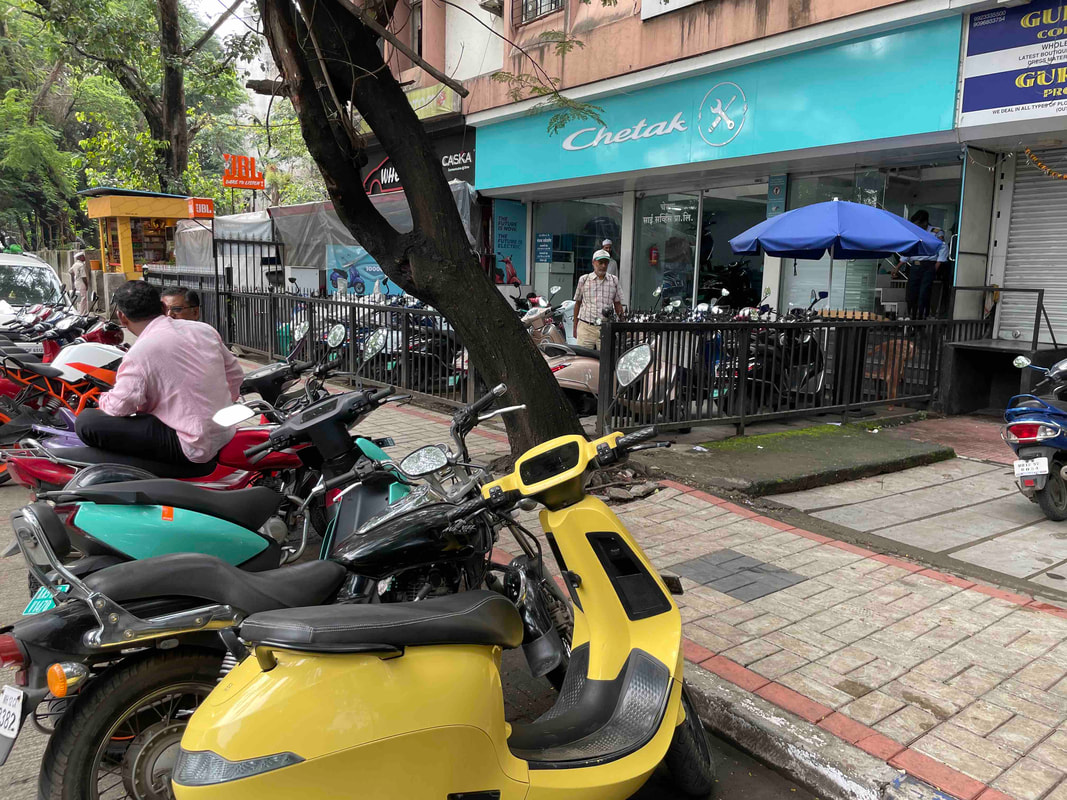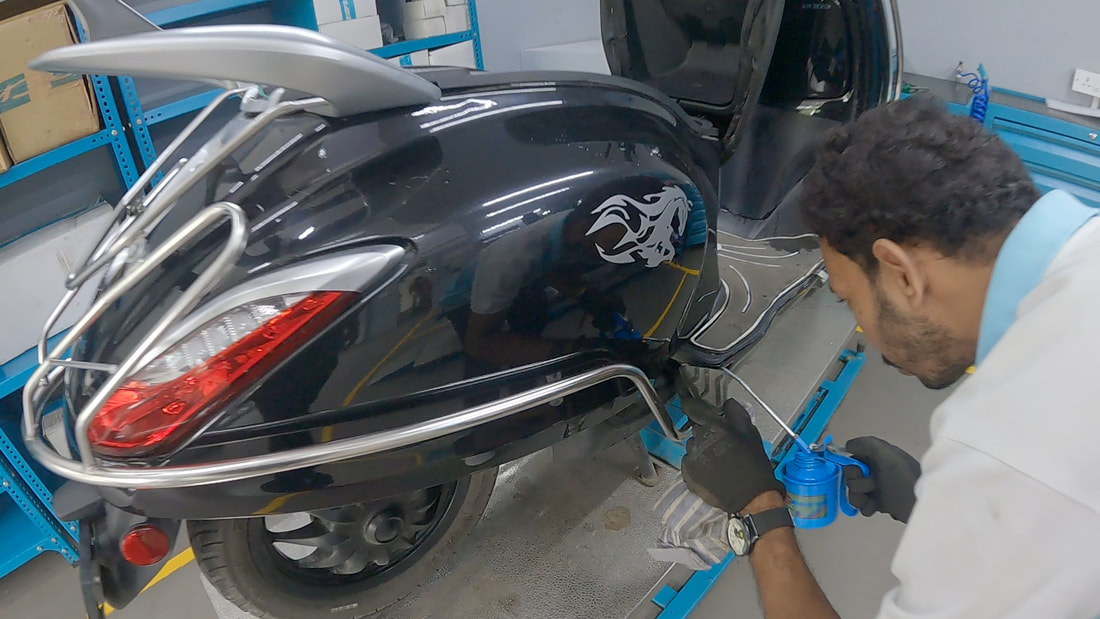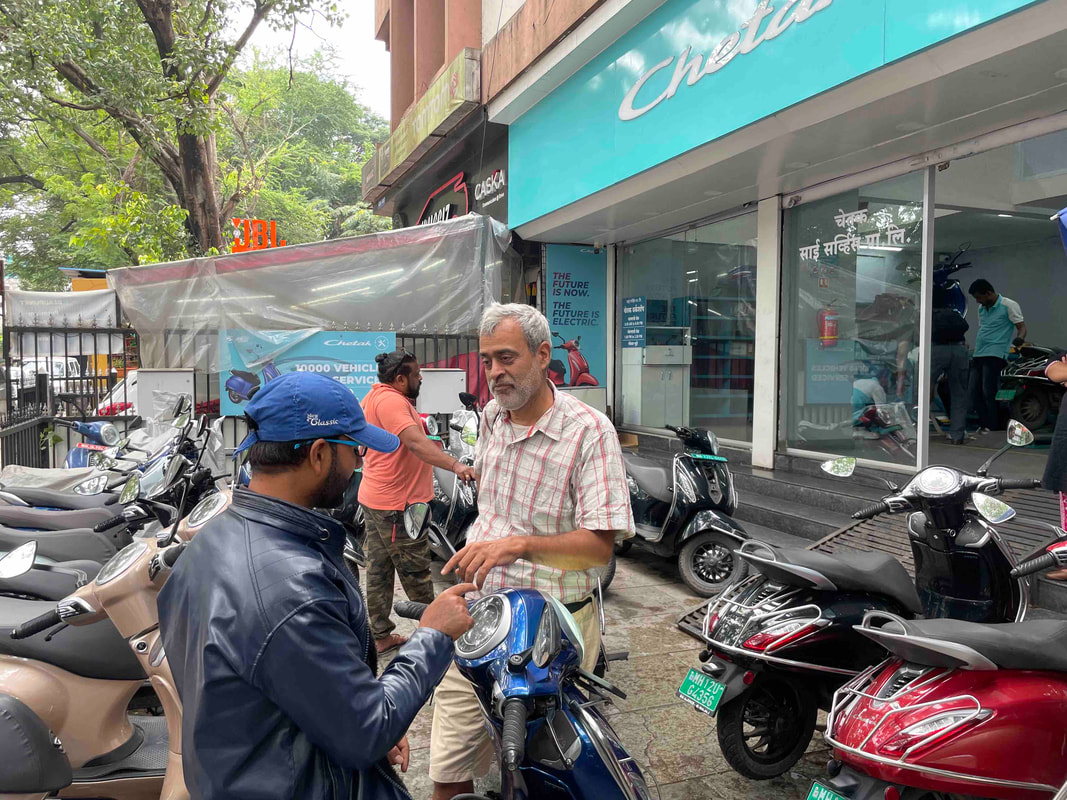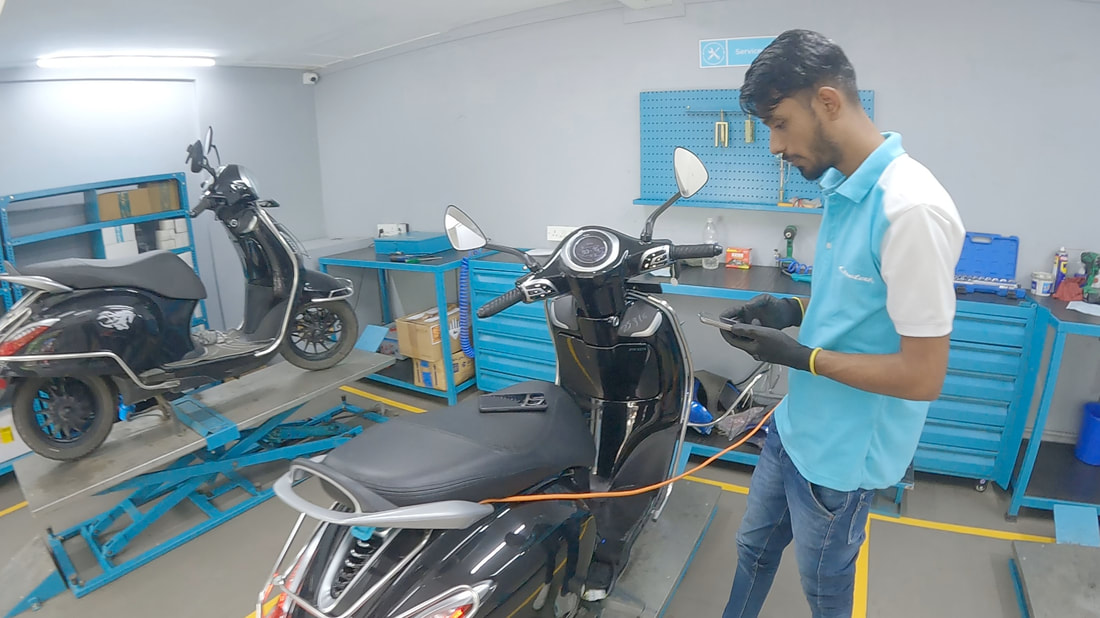By Atul Gopal
The PluginIndia team got an opportunity to visit the dedicated service center for EV's. These centers are dedicated service centers for the Chetak and future Bajaj EV's. Here are our observations from our visit.
To get to the Chetak service center at Rasta peth, the landmark is Shantai Hotel. Met with Piyush there. Piyush is an after sales service expert. He started his career with Renault in Ranchi before moving to Tata in Guwahati and has been with Bajaj in Pune for the last one year. He looks after after-sales in Maharashtra. There is currently one service center in Pune, at Rasta Peth, operated by Sai Service. The second one is slated to open soon at Fugewadi, also operated by Sai Service. Chetaks are currently being serviced at Fugewadi, but will be having an exclusive center there soon. In all, there are 40 exclusive EV service centers operated by Bajaj today.
As of Oct 22, there are 7,000 Chetaks on the road in Pune. With vehicles coming in after first 1,000 km and then in intervals of 10,000 – there is enough service load. But the economics of servicing are still not too great. All the vehicles come within warranty – and are usually zero dep. So there are no profitable ‘paid’ services. (There has only been one till date.) The team of 4 mechanics is able to do about 25 service jobs a day. Assuming the rental to be about 90 K – and assuming an average salary of about 20 K for the total team of 9, salaries are around 2 lakh a month. Add another 50 K for other costs – and monthly fixed costs will hover around 3.5 lakh. Apportioned over 25 * 26 = 650 service events, fixed costs per service are around 350,000/650, almost Rs. 550.
About 40-50 accident cases have been reported so far – all covered under zero dep. Most of the accidents happen when erstwhile motorcycle riders switch to the Chetak. They take turns at speeds which are more appropriate to bikes than scooters – and learn like Humpty Dumpty did from the wall. Another interesting observation is that quite a few owners want to come and get their scooters repaired even for minor scratches – zero dep hai na. Assuming that Bajaj Allianz is the preferred insurer, I can conclude that Sanjiv’s loss is Rajiv’s gain.
In the first service, nothing is opened up. The error log is looked at using a diagnostic tool. If there are any errors, they are taken care of. If there are any company mandated part replacements, that is taken care of. Next there is a general tightening of the suspension bolts. Also the e-throttle spring is adjusted if any play is detected. Battery connections are checked for tightness. And finally after the usual cleaning, the vehicle is returned back to the owner. The 10 K km service is more elaborate – everything in the 1000 km service is repeated – and some more. The vehicle is opened up for a closer inspection. I assume that brake adjustments are made. There is of course nothing like an oil change – so the service team is deprived of its basic moolah.
As of Oct 22, there are 7,000 Chetaks on the road in Pune. With vehicles coming in after first 1,000 km and then in intervals of 10,000 – there is enough service load. But the economics of servicing are still not too great. All the vehicles come within warranty – and are usually zero dep. So there are no profitable ‘paid’ services. (There has only been one till date.) The team of 4 mechanics is able to do about 25 service jobs a day. Assuming the rental to be about 90 K – and assuming an average salary of about 20 K for the total team of 9, salaries are around 2 lakh a month. Add another 50 K for other costs – and monthly fixed costs will hover around 3.5 lakh. Apportioned over 25 * 26 = 650 service events, fixed costs per service are around 350,000/650, almost Rs. 550.
About 40-50 accident cases have been reported so far – all covered under zero dep. Most of the accidents happen when erstwhile motorcycle riders switch to the Chetak. They take turns at speeds which are more appropriate to bikes than scooters – and learn like Humpty Dumpty did from the wall. Another interesting observation is that quite a few owners want to come and get their scooters repaired even for minor scratches – zero dep hai na. Assuming that Bajaj Allianz is the preferred insurer, I can conclude that Sanjiv’s loss is Rajiv’s gain.
In the first service, nothing is opened up. The error log is looked at using a diagnostic tool. If there are any errors, they are taken care of. If there are any company mandated part replacements, that is taken care of. Next there is a general tightening of the suspension bolts. Also the e-throttle spring is adjusted if any play is detected. Battery connections are checked for tightness. And finally after the usual cleaning, the vehicle is returned back to the owner. The 10 K km service is more elaborate – everything in the 1000 km service is repeated – and some more. The vehicle is opened up for a closer inspection. I assume that brake adjustments are made. There is of course nothing like an oil change – so the service team is deprived of its basic moolah.
One mystery that got solved in the interaction was the reason for the erratic behavior of the turn indicator cut off. There is a magnet on the steering column – which detects rotation – and hence cuts off once the handle returns to its straight ahead position. When we take a high radius turn – or when we change direction simply be weight shifting – the sensor does not detect the return back to straight position – as we never turned the handle in the first place. So it continues to annoyingly be on – even when the turn is completed. It is better to use a small IC gyro to check change in direction – and consistently switch off the indicator. Will lead to a huge decrease in customer dissatisfaction – and also safety.
A common problem that is detected is alignment of the front dicky. What happens is that inadvertently a heavy weight is placed on the horizontal lid – and the alignment of the hinges goes for a toss. At other times, attempts are made to push in too much into the very limited space there – and so the door closure is affected, My advice to Bajaj team is that the buzzer should operate when the front dicky is also opened – this will prevent the absent minded loading of the dicky lid.
The motor is a 3 phase PMSM motor. The PMSM motor is a better design than a hub motor for higher power – as cooling happens better, with the copper windings being on the outside, and the ferrite magnets being on the rotor inside. The motor has fixed twin reduction through helical gears. Ratio of motor speed to wheel speed is about 9 : 1. With the 12 inch rim dia wheel going at 700 rpm when vehicle is at top speed of 60 kmph, the corresponding motor speed is about 6,000 rpm. There is no change in gear required as the starting torque of the motor is the highest at 0 rpm. The motor controller, the on board charger and the DC DC converter modules are all located in the rear wheel well area. Most of these modules have fins – and it is a good idea to clean them up with a water spray once in a while. The company recommends using a jet with a pressure of less than 10 bar. Also avoid directing the jet towards the connectors.
A common problem that is detected is alignment of the front dicky. What happens is that inadvertently a heavy weight is placed on the horizontal lid – and the alignment of the hinges goes for a toss. At other times, attempts are made to push in too much into the very limited space there – and so the door closure is affected, My advice to Bajaj team is that the buzzer should operate when the front dicky is also opened – this will prevent the absent minded loading of the dicky lid.
The motor is a 3 phase PMSM motor. The PMSM motor is a better design than a hub motor for higher power – as cooling happens better, with the copper windings being on the outside, and the ferrite magnets being on the rotor inside. The motor has fixed twin reduction through helical gears. Ratio of motor speed to wheel speed is about 9 : 1. With the 12 inch rim dia wheel going at 700 rpm when vehicle is at top speed of 60 kmph, the corresponding motor speed is about 6,000 rpm. There is no change in gear required as the starting torque of the motor is the highest at 0 rpm. The motor controller, the on board charger and the DC DC converter modules are all located in the rear wheel well area. Most of these modules have fins – and it is a good idea to clean them up with a water spray once in a while. The company recommends using a jet with a pressure of less than 10 bar. Also avoid directing the jet towards the connectors.
One thing that is checked is the health of the auxiliary battery. The lead acid aux battery is placed below the floorboard – and is warrantied for 1.5 years. Aux battery failures happen more often – and as of now, are being replaced under warranty. Once the aux fails, there are wake-up problems in the vehicle. Also, the dickies cannot be opened, as the lids are opened by solenoids. The battery costs Rs. 1200 – and customers need to be educated that this is not the main battery.
The 20 kg main battery is really well designed. It has an extrusion – with a plastic lid at both ends. It lies horizontal below the dicky – and thereby helps lower the CG. There are two electrical connectors – one for HV– and the other is the CANN port. What I also liked is that the Bosch diagnostic tool also detects State of Health. And I can’t resist sharing the good news about a SoH exercise carried out on about 50 vehicles at the Pune service center. The lowest SoH that a battery reported was 97% - and that too for a vehicle that has run 40,000 km. Wow! The company has committed a 7 year, 70% SoC – so we can safely assume that Laxman Rekha will be unlikely to be crossed by a Chetak. And the realistic life should be 10 years +, which is excellent.
The 20 kg main battery is really well designed. It has an extrusion – with a plastic lid at both ends. It lies horizontal below the dicky – and thereby helps lower the CG. There are two electrical connectors – one for HV– and the other is the CANN port. What I also liked is that the Bosch diagnostic tool also detects State of Health. And I can’t resist sharing the good news about a SoH exercise carried out on about 50 vehicles at the Pune service center. The lowest SoH that a battery reported was 97% - and that too for a vehicle that has run 40,000 km. Wow! The company has committed a 7 year, 70% SoC – so we can safely assume that Laxman Rekha will be unlikely to be crossed by a Chetak. And the realistic life should be 10 years +, which is excellent.




